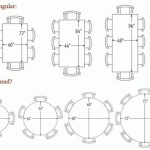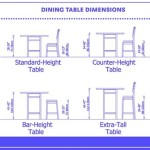Determining Optimal Chair Height for Dining Table Harmony
Achieving a comfortable and aesthetically pleasing dining experience hinges significantly on the relationship between the dining table height and the dining chair height. An imbalance in these measurements can lead to discomfort, poor posture, and an ultimately unsatisfying dining experience. This article will explore the factors that influence the ideal chair height for a dining table, providing guidelines and considerations for selecting the appropriate furniture to ensure optimal comfort and functionality.
The standard dining table height typically ranges between 28 and 30 inches. This range has evolved to accommodate the ergonomic needs of the average adult, providing sufficient legroom and space for comfortable reaching. However, variations exist, and some tables may deviate from this standard. These variations necessitate careful consideration when selecting chairs, as the chair height must be appropriately scaled to the specific table height. Failure to do so can result in a dining setup that feels awkward or impractical.
Several factors contribute to creating a balanced dining environment. These factors include the height of the diners, the style of the chairs, and the intended use of the dining space. Understanding these variables is crucial for making informed decisions regarding chair height selection and ensuring a comfortable and enjoyable dining experience for all users.
The importance of proper chair height extends beyond mere comfort. Incorrect chair height can contribute to poor posture, leading to back pain and discomfort. Similarly, an improperly sized chair can make it difficult to reach the table, causing strain and frustration during meals. By carefully considering the relationship between table and chair height, individuals can create a dining space that promotes both physical well-being and enjoyable social interaction.
Understanding the 12-Inch Rule
The most widely accepted guideline for determining the appropriate chair height is the “12-inch rule.” This rule suggests that there should be approximately 12 inches of space between the top of the chair seat and the underside of the dining table. This spacing allows for adequate legroom and promotes comfortable posture while dining. While this rule serves as a useful starting point, it is important to recognize that individual preferences and body types may necessitate adjustments.
To apply the 12-inch rule effectively, it is essential to accurately measure the height of the dining table from the floor to the underside of the table apron (the frame that supports the tabletop). Once this measurement is obtained, subtracting 12 inches will provide a preliminary estimate of the ideal chair seat height. This estimate can then be refined based on individual needs and preferences. For example, taller individuals may benefit from slightly more than 12 inches of space, while shorter individuals may find 11 inches to be more comfortable.
The 12-inch rule assumes a standard table height and chair design. However, variations in table thickness and chair seat depth can influence the perceived comfort of the dining setup. A thicker tabletop, for example, may reduce the available legroom, necessitating a slightly lower chair height to maintain the recommended 12-inch spacing. Similarly, a deeper chair seat may require additional clearance under the table to prevent the diner from feeling crowded.
The 12-inch rule is not a rigid requirement but rather a flexible guideline. Personal comfort and preferences should always be prioritized when selecting chair height. It is advisable to test different chair heights with the dining table to determine what feels most comfortable and supportive. Consider the angle of the knees when seated and the ability to maintain a relaxed and upright posture. Adjustments to the chair height, even by an inch or two, can significantly impact the overall dining experience.
Furthermore, the 12-inch rule should be considered in conjunction with other factors, such as the style and design of the chairs. Chairs with armrests, for example, may require additional clearance under the table to ensure that the armrests can slide comfortably underneath. Similarly, chairs with high backs may require a slightly lower seat height to maintain a balanced visual aesthetic within the dining space. A holistic approach to chair height selection, taking into account both ergonomic principles and design considerations, is crucial for achieving a harmonious and functional dining environment.
Considering Dining Chair Style and Design
The style and design of dining chairs play a significant role in determining the appropriate chair height. Chairs with different back heights, armrests, and seat depths may require adjustments to the standard 12-inch rule to ensure optimal comfort and functionality. It is essential to consider these stylistic elements when selecting chairs to complement a dining table.
Chairs with armrests, for example, require careful consideration of the armrest height in relation to the table height. The armrests should ideally fit comfortably under the table apron, allowing the chair to be pushed in fully when not in use. This prevents the chairs from protruding into the room and creating a cluttered or awkward appearance. To achieve this, the height of the armrests must be measured and compared to the height of the table apron.
Chairs with high backs can create a more formal and elegant dining atmosphere. However, they may also require a slightly lower seat height to maintain a balanced visual aesthetic. A chair with a very high back, when paired with a standard-height table, may overwhelm the space or appear disproportionate. Lowering the seat height slightly can help to compensate for the height of the backrest and create a more visually harmonious composition.
The seat depth of a dining chair also influences the perceived comfort and functionality of the dining setup. Chairs with deeper seats may require additional legroom under the table to prevent the diner from feeling cramped or restricted. Selecting chairs with appropriate seat depth is particularly important for individuals with longer legs or those who prefer to sit further back in their chairs.
The overall style of the chairs should complement the style of the dining table and the surrounding decor. A modern dining table, for example, may be best paired with sleek, minimalist chairs. A more traditional table may be better suited to chairs with more ornate detailing or classic silhouettes. The choice of chair style can significantly impact the overall aesthetic of the dining space, so it is important to consider the design elements carefully.
Upholstered dining chairs offer additional comfort and support. However, the thickness of the upholstery can affect the overall seat height. It is important to factor in the thickness of the upholstery when measuring the seat height to ensure that the chairs are appropriately sized for the table. Overly plush upholstery may raise the seat height to an uncomfortable level, while insufficient padding may result in a less supportive and less enjoyable dining experience.
Accounting for Individual Height and Posture
While the 12-inch rule and considerations of chair style provide a solid foundation for selecting the appropriate chair height, it is crucial to account for individual height and posture. Diners of different heights may require adjustments to the standard guidelines to achieve optimal comfort and ergonomic support. Similarly, individuals with specific postural needs may benefit from chairs with different seat heights and back support features.
Taller individuals generally require more legroom than shorter individuals. Therefore, they may benefit from increasing the distance between the chair seat and the underside of the table by an inch or two. This additional space provides ample legroom and prevents the knees from bumping against the table apron. Conversely, shorter individuals may find that a slightly smaller gap between the chair seat and the table is more comfortable, allowing them to reach the table easily without straining.
Posture plays a critical role in maintaining comfort and preventing back pain during extended periods of sitting. A chair with adequate lumbar support can help to promote proper spinal alignment and reduce strain on the lower back. Similarly, a chair with a slightly forward-sloping seat can encourage a more upright posture and prevent slouching. Individuals with pre-existing back problems should prioritize chairs with strong lumbar support and adjustable seat height to customize the chair to their specific needs.
The height of the table itself should also be considered in relation to individual height. If the dining table is significantly taller or shorter than the standard 28-30 inch range, corresponding adjustments to the chair height will be necessary. A taller table, for example, may require taller chairs to maintain the appropriate legroom and reach. Conversely, a shorter table may necessitate shorter chairs to prevent the diner from feeling too high above the table surface.
Consideration should also be given to the types of activities that will be taking place at the dining table. If the table is primarily used for formal dining, chairs with a more upright posture and supportive backrests may be preferred. If the table is also used for casual activities such as working or playing games, chairs with a more relaxed posture and greater freedom of movement may be more suitable. The intended use of the dining space should inform the selection of chair height and style.
Ultimately, the optimal chair height is a matter of personal preference and individual needs. It is advisable to try out different chair heights and styles to determine what feels most comfortable and supportive. Consider sitting at the table for an extended period of time to assess the comfort of the chairs and ensure that they provide adequate support for the back and legs. Paying attention to these details will help to create a dining space that is both comfortable and aesthetically pleasing.

What Is The Ideal Dining Table And Chair Height

How To Pick The Right Dining Chair Height Inside

What Is The Ideal Dining Table And Chair Height

Dining Table Height Chair

Right Fit For Dinner A Table And Chair Sizing Guide Timber To

What Are Standard Table Heights

Dining Pub Chair Seat Height Comparison Find The Perfect Fit Amish Furniture Factory

What Is The Ideal Dining Table And Chair Height

Seat Height Table

What Is The Ideal Dining Table And Chair Height








